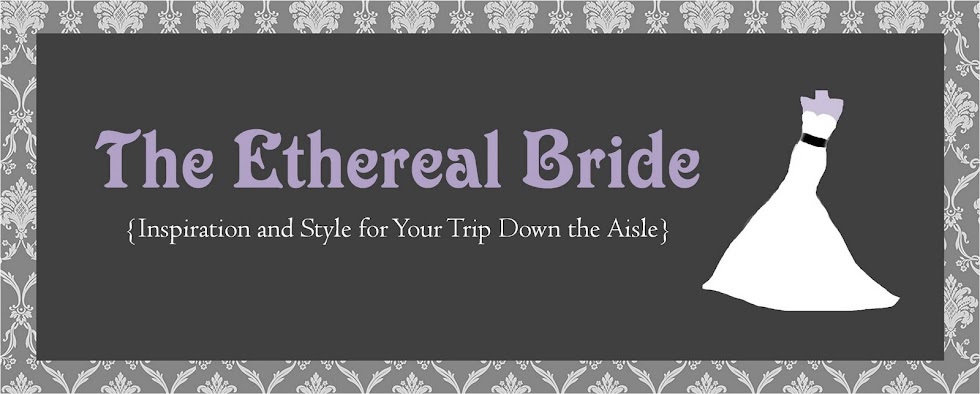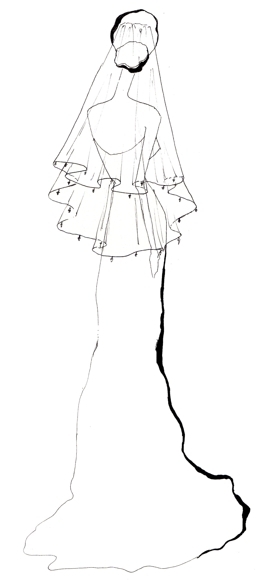There are a few things to consider when choosing a veil- width, length, cut, color, and what types of embellishments you want. I will explain each of these in greater detail below...
Width:
The width of the veil is determined by the width of the fabric before it is gathered. Veils typically come in two standard widths- 108" and 72" wide. Basically, the wider the veil, the poofier it will be. Most veils are 108", but if you are going for a simpler look then the 72" size might be the way to go. Veils can be made out of any width fabric, so if you want something even fuller than 108" or slimmer than the 72", then some veil companies will make custom changes.
Length:
There are lots of different lengths to choose from when picking your veil. The exact measurement differs based on your height, so they will either order a standard measurment (each company's are different) or they will do a custom measured length.
Chin length
Chin length is most typically seen in a Russian or French netting style, but can sometimes also be seen in tulle (like the one pictured) and can be worn either as a blusher or as a veil. It is best paired with sophisticated, minimalistic gowns.
Veil by Sara Gabriel, style "Drew"
Shoulder length.
Shoulder length is a lesser common style, but can still be really pretty. It is best paired with less formal styles.
Veil by Sara Gabriel, style "Emma"
Elbow Length
Elbow length is a very common style. It is best paired with gowns that don't have a lot of detail on the back of the dress and don't have a definitive waist seam, such as a plain mermaid or sheath style (like the style illustrated below). The reason being the veil creates a line across your back and can detract from pretty details on the back of the dress and can also cut you off in a weird spot.
Veil by Sara Gabriel, style "Ava"
Fingertip Length
Fingertip length is a great length because it is a short style but doesn't cut you off like elbow length does. It is also versatile as far as what styles it works best with. It can be paired easily with simple or more formal styles, as long as it hits about an inch or so below the waist line of the dress. Otherwise you run into the same issues as you do with elbow length.
Veil by Sara Gabriel, style "Jessica"
Knee Length
Knee length is another versatile length that works well with many styles of gowns. It is long enough to not disrupt the details on the back of the dress, but short enough to be out of the way. Just make sure that it isn't cutting off any of the pretty train details.
Veil by Sara Gabriel, style "Sabina"
Floor Length
Floor length is great because you aren't cutting off the dress in a strange spot, but you can continue wearing it at the reception without it getting trampled. It works fine with pretty much any style.
Veil by Sara Gabriel, style "Renee"
Chapel Length
Believe it or not, chapel length is actually one of the most versatile and flattering veil styles. Because it hits an inch or two past the train, it doesn't compete with the back of the gown at all. It blends right into the dress, allowing the pretty details on the back of the dress to show through. It works great with any style, even less formal ones (just embellish the veil accordingly), just as long as the train of the dress is an inch or two shorter than the veil.
Veil by Sara Gabriel, style "Renee"
Cathedral Length
The same rules apply to cathedral length as chapel length. It looks gorgeous with any style (including less formal styles), just make sure it hits at least an inch or two past the train of the gown.
Veil by Sara Gabriel, style "Carolina"
Cut:
The cut of a veil determines the way the veil hangs and looks. There are tons of different cuts, but I'm going to focus on the major ones.
Classic Round
The classic round style is the most common style. It is cut from a large rectangular piece of tulle with rounded bottom edges. It can be made into any length.
Veil by Sara Gabriel, style "Grace"
Classic Square
The classic square is the same as the classic round, but the edges aren't rounded. It can also be made into any length and looks great with any style gown.
Veil by Sara Gabriel, style "Katie"
Mantilla
The mantilla is a traditional European style that is cut from a oval shaped piece of tulle and isn't gathered. Traditionally is is edged with lace trim, but can be plain or have other types of embellishments as well. It can be made into any length and looks great with any style gown.
Veil by Sara Gabriel, style "Dahlia"
Cascade/ Waterfall
This style features an edge that ripples down. It looks best with a simpler style gown because the veil's unique shape can detract from the gown. Sometimes it's cut to look like it is two separate layers- one long and one short, like the "Ella" style below.
Veil by Sara Gabriel, style "Ella"
Veil by Sara Gabriel, style "Lena"
Veil by Sara Gabriel, style "Breanna"
Blusher
The blusher style is cut a few different ways, and it is pinned to your hair to cover your face.
Veil by Sara Gabriel, style "Collette"
Color
Veils typically come in at least white and ivory, but usually more colors too. The key is to try and match the color of your veil to your gown exactly. Ignore the color names because everyone's version of color is different. Instead hold veil swatches up to your dress and go from there. If there isn't an exact match, then go with the veil color that is a shade darker. Never go lighter with the veil color or else your gown will look dirty.
Embellishments
There are a number of different ways to embellish a veil. It all just depends on how detailed your dress is and what your tastes are.
Lace
Lace is gorgeous, but can be a bit overwhelming. It looks best with lace gowns or more plain styles, but can also work with detailed gowns too, it just depends on your taste.
Alencon lace veil by Sara Gabriel, style "Kristen"
Rhinestones
Rhinestones add sparkle to your veil. Make sure you choose a company that puts rhinesones on each side of the tulle, back to back. Otherwise you see the glue on the other side- not pretty.
Rhinestone embellished veil by Sara Gabriel, style "Karen"
Pearls
Pearls add a pretty, classic touch to your veil. The also look great combined with rhinstones and crystals.
Pearl detailed veil by Sara Gabriel, style "Audrey"
Soutache trim
Soutache is a braided trim that adds a level of elegance to veils. It best matched with a simple style gown.
Soutache trimmed veil by Sara Gabriel, style "Ava"
Veils can also be trimmed with ribbon or have a "pencil edge" using fine tread. Anytime you have a thick edge, it can sometimes create a frame around you, so they are typically best paired with a simpler gown.
So what's the deal with blushers?
A blusher is a layer of tulle that folds over your face and gets put to the back during the ceremony. It is completely a matter of personal preference whether or not to have one. Alot of times the longer layers of the veil are made detachable, so you just have the short blusher layer for the reception.
Have other questions about veils?? Feel free to ask in the comments sections!!
-A
Related Posts:




















No comments:
Post a Comment
Hello lovely readers! I am dying to know what you all think of my posts, so by all means do tell! Please keep in mind, though, I wont approve any comments that are really mean-spirited or clearly self-promoting. {♥ A}